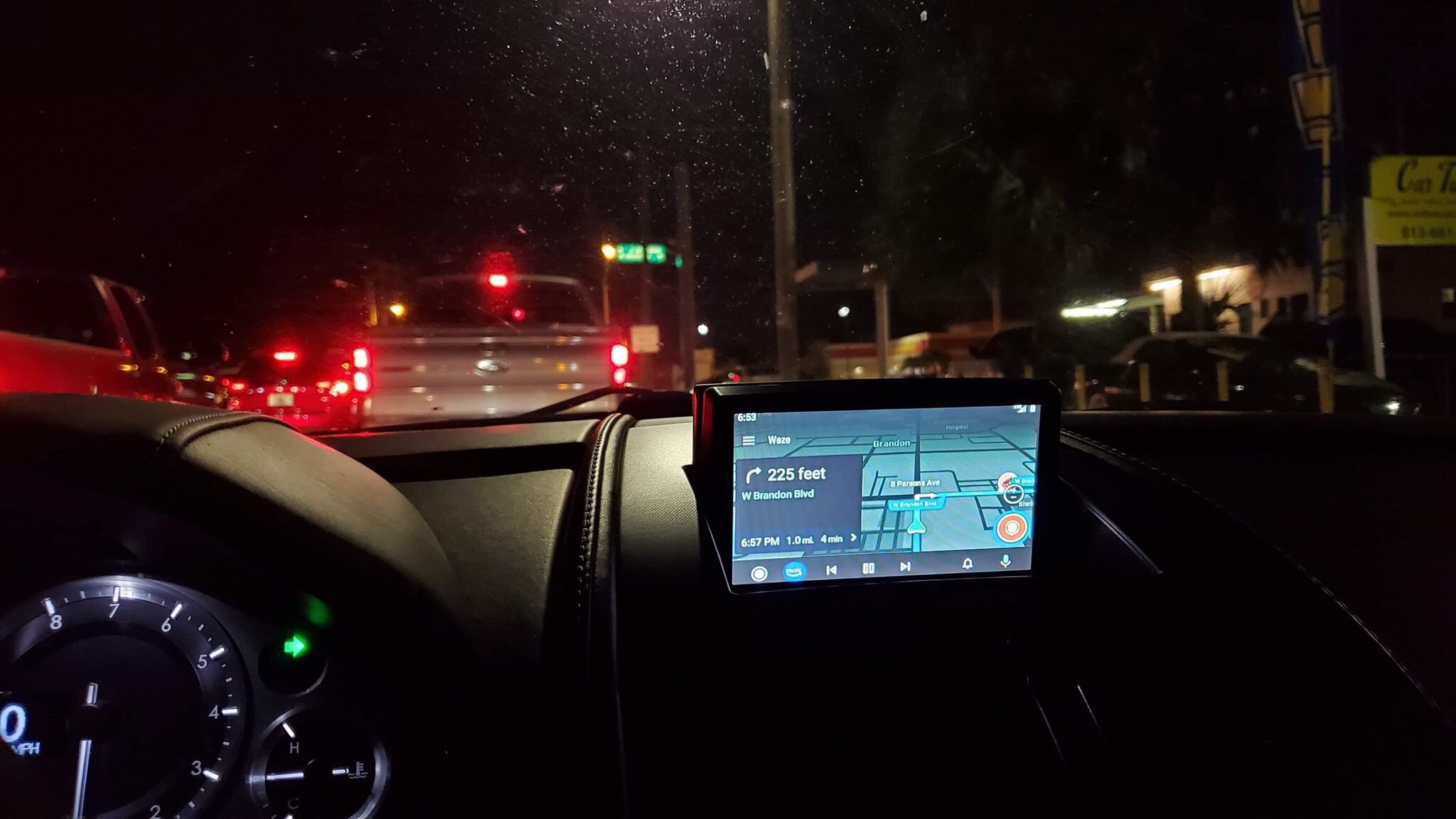
Infotainment System Information
DISCLAIMER
The information provided here is for general guidance purposes only. It is a combination of manufacturer guidance, first- and second-hand experience, and personal opinion. It may me inaccurate, incomplete, or outdated.
An infotainment system can be a major selling point - or a major detractor - when it comes to buying a vehicle. Infotainment (a portmanteau of information and entertainment) may be a secondary priority for most buyers but it gets used almost constantly by many. The term collectively includes the music (AM/FM stereo, CDs, streaming audio, etc), navigation, in-car and exterior temperature readings, hands-free calling, and their associated controls and displays, which are equipped in a vehicle.
Modern infotainment systems are often so integrated into the vehicle that they can't be changed in a simple way and may need some fairly comprehensive modifications to add functionality. And that's usually the case with Aston Martins.
Return to Information Pages index
Jump to Section

General Infotainment Information
Aston Martins have not been known for their cutting-edge technology. And when they do have something that's a bit forward-thinking, it may not quite go as well as they'd hope. You can take a look at the CRT displays used in the old Aston Martin Lagonda some decades ago. This lackluster part of Aston Martin did carry over to some facets of the Gaydon-era cars, and the widely-panned Volvo-based navigation system and lack of standard features did quite a bit to push that narrative.
AMi Variants
The Aston Martin infotainment (AMi) system had three variants through the Gaydon era.
AMi I was the original system as used on all of the cars starting with the DB9 and V8 Vantage. The system used traditional buttons and knobs for the controls, which were updated in style for MY09, and a Volvo-based navigation system that was upgraded to a Garmin-based system during MY12.
AMi II was introduced on the MY13 Vanquish and then used across all cars for MY16. It featured touch-sensitive buttons with haptic feedback that made the interiors of cars with this system stand out considerably from the previous AMi I system. New features included visual displays for engine power output and a steering-sensitive reverse camera.
AMi III came out for MY17 and featured a range of performance improvements over the AMi II system for graphics, menus, responsiveness, graphics, and satellite navigation system. AMi II cars can be upgraded to the AMi III system, but it can be pretty expensive - between parts and labor it can cost several thousand dollars.
Fiber Optics
Aston Martin uses a CAN-bus network running over a pair of fiber optic cables that create a loop around the car. While this system does provide for a lot of data to be carried around the vehicle, it can also cause quite a few headaches for repairs or modifications. Doing certain modifications may require tapping into the fiber optics, which can be tricky to do correctly. There are a couple aftermarket products out there that do this, and I had my grey 2007 V8 Vantage set up with one for a while until I swapped it out for the Infotainment Upgrade Kit that I now use.
More important to know about the fiber optics is when it comes to repairs - and more specifically, to warning lights that prompt those repairs. A common issue for convertible cars is the convertible roof module (CRM) going bad. Because it’s part of the CAN-bus system, a failing (or failed) CRM will disrupt the data flow and cause a bunch of warning lights and error messages to pop up on the gauge cluster. It’s a terrifying thing to see all those warnings come out of nowhere when there doesn’t seem to be anything wrong with the car. Check out my Information Page about convertibles for more details.
Apple CarPlay and Android Auto
The only Aston Martins with Apple CarPlay available from the factory until the DBX was released were MY17.5-18 cars with AMi III. So, a very small number from the very end of the Gaydon era. It's possible to fit an Infotainment Upgrade Kit that allows both Apple CarPlay and Android Auto to a Gaydon-era car, but it does require an extra control knob and screen selection button to be added as well (they're included in the kit). Many of the Aston owners I talk to say they prefer to listen to the exhaust note, but having gotten used to the utility and practicality of having Android Auto in my Astons, it's one of the best things I've done to my cars and the first thing I'll do when I get another.

Audio Systems
Each of these system covered below will have a watt rating. The watts listed for an audio system are the total output of all the speakers combined. There's tons of information on the internet about stereo systems in general so have fun digging into that if you want. The information here is specifically about the audio systems for these cars.
Linn Audio
The DB9 originally used audio systems from Linn Audio up until MY08. There were three available: the standard system with 128 watts, an upgraded version with 260 watts, and a top-level system putting out 950 watts. These systems weren’t the best and they haven't aged well, making them that much less desirable. Even the top of the range system wasn’t very impressive despite its 950w rating. The Linn Audio systems were replaced by the 700w Alpine Premium Audio as the standard audio system for the DB9 in MY08.
Standard V8 Vantage System
The standard audio system for the V8 Vantage was a 160w system. It had a pair of 40w door speakers and an 80w subwoofer. It was pretty lackluster, which is why many Aston Martin owners and buyers (myself included) consider the Premium Audio to be a must-have option. The cost of the parts to upgrade from the standard system to the Premium Audio is a couple thousand dollars, plus it can take a full day to install, and then a config file will be needed from an Aston Martin dealership to update the car’s firmware to work the system.
Alpine Premium Audio System
Alpine supplied a bespoke audio system that was commonly known as Premium Audio, though it's sometimes referred to by its 700-watt rating. It featured additional speakers plus a more powerful subwoofer compared to the standard 160w audio system. It was the upgrade option for the V8 Vantage but fitted as standard on other cars. If you're not sure whether or not a car has the Premium Audio system, watch the radio display panel while starting the the car. The startup screen on the panel will say "Premium Audio" if the 700w system is equipped.
The Premium Audio cost approximately $1500 as an option for the V8 Vantage while being standard on other models. It’s is widely regarded as a fantastic system, especially given the price even as an extra-cost option.
Bang & Olufsen
The top of the line audio system was supplied by Bang & Olufsen (B&O) and put out 1000 watts. It's easy to see if a car has this system because of the pop-up tweeters. You'll see them sitting quite obviously on the outer corners of the dashboard, and they'll rise up when in use. The B&O system was considerably more expensive than the Alpine Premium Audio, costing several thousand dollars. Given the cost, many buyers and current owners have been happy with the Premium Audio system.
The B&O system was standard on the Vanquish as well as some DBS and Rapide cars.
Audio Inputs
The cars featured AM/FM radio and a 6-disc CD changer up until MY08, at which point a USB port was added. The USB port was located in the center armrest and could be used with the factory-supplied 30-pin connector for an iPod or Bovee 1000. Prior to the USB port being added, there was no way to easily connect an auxiliary device like an iPod or Bovee.

The factory navigation system was an option on the V8 Vantage but standard for all other cars. Even though it doesn’t have a great reputation, the optional nav system in the Vantage is so commonly equipped that it may as well be de facto standard. It’s actually quite uncommon to see a car without it.
The original navigation (“nav”) system was pulled directly from Volvo. It wasn't the most beloved system out there and has been widely criticized for being woefully outdated. I can't really argue with that - I used navigation apps on my phone instead of my car's factory nav system and honestly never opened the nav screen at all until getting an infotainment system upgrade that allowed me to link my phone to that screen.
The Volvo nav system used DVDs for its maps. Updated versions of these can be gotten from Volvo much less than Aston Martin sells them. And, even though it says Volvo on the cover, the nav screen will still say Aston Martin - so, don’t worry about having the wrong logo when using Volvo map discs.
Aston Martin switched out the Volvo-based system for a Garmin system, which was a huge improvement. The Garmin nav system was first introduced on the MY11 Virage and was then rolled out to the other models during MY12. Because it was a transition year for the navigations systems, some MY12 cars will still have the Volvo system.
While the Volvo system used DVDs for maps, the Garmin system uses SD cards. The SD cards can have updated maps loaded onto them to make updates easier than having to buy new DVDs as was previously required.

Parking Cameras
A rear parking camera was made available around MY10 for the DB9 and DBS with the Volvo navigation system, and then was offered starting at MY13.5 for cars with the Garmin navigation system. Video from the reversing camera will automatically be shown on the navigation screen when the transmission is put in Reverse gear. When the transmission is out of Reverse gear, the nav screen automatically reverts back to what it had been showing before.
It was updated with the AMi II infotainment system to include steering-sensitive guidelines that would change angled based on steering input.
Front parking cameras were not offered from the factory on Gaydon-era cars, but were introduced in 2nd Century cars with the DB11. A front camera can be added by using an Infotainment Upgrade Kit.

